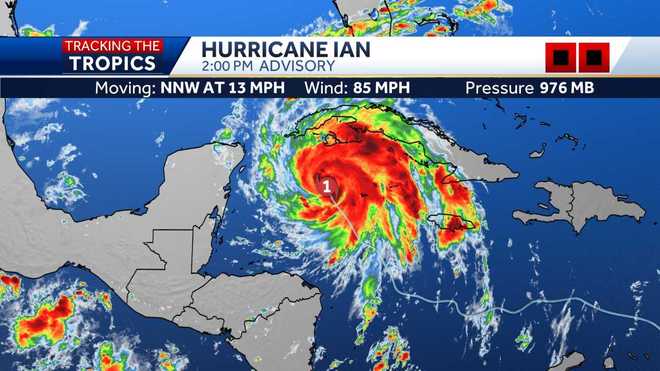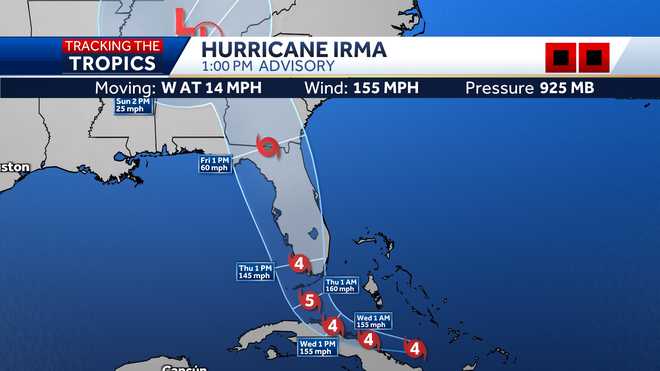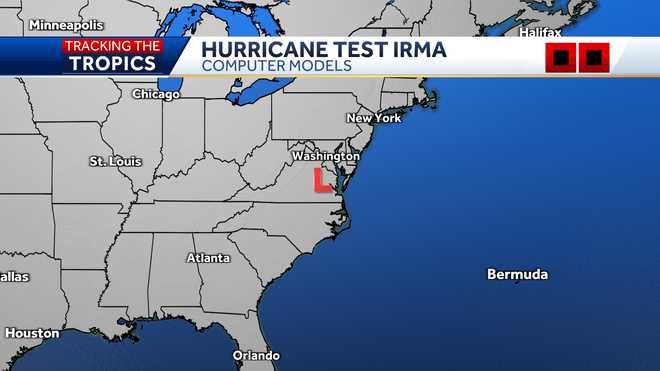[ad_1]
Hurricane Ian was growing stronger as it approached the western tip of Cuba on a track to hit the west coast of Florida as a major hurricane as early as Wednesday. Ian was forecast to hit Cuba as a major hurricane and then become an even stronger Category 4 with top winds of 140 miles over warm Gulf of Mexico waters before striking Florida along a stretch of coast including the Tampa Bay area.As of Monday, Tampa and St. Petersburg appeared to be among the most likely targets for their first direct hit by a major hurricane since 1921.“Please treat this storm seriously. It’s the real deal. This is not a drill,” Hillsborough County Emergency Management Director Timothy Dudley said at a Monday news conference on storm preparations in Tampa.Authorities in Cuba suspended classes in Pinar del Rio province and planned evacuations Monday as Ian gained strength on approach to Grand Cayman and the Cuban provinces of Isla de Juventud, Pinar del Rio and Artemisa. Cuba also was shutting down its train system ahead of the worst weather.“Cuba is expecting extreme hurricane force winds, also life threatening storm surge and heavy rainfall,” U.S. National Hurricane Center senior specialist Daniel Brown told The Associated Press early Monday.The hurricane center predicted areas of Cuba’s western coast could see as much as 14 feet of storm surge Monday night or early Tuesday.On Monday afternoon, Ian was moving northwest at 13 mph about 195 miles southeast of the western tip of Cuba, with top sustained winds increasing to 85 mph.Video below: FEMA discusses best preparations ahead of Hurricane IanThe center of the hurricane was passing to the west of the Cayman Islands, where Premier Wayne Panton said the government and its opposition were working together to keep the people as safe as possible. “We must prepare for the worst and absolutely pray and hope for the best,” Panton said in a video posted Sunday. Ian won’t linger over Cuba, but will slow down over the Gulf of Mexico, growing wider and stronger, “which will have the potential to produce significant wind and storm surge impacts along the west coast of Florida,” the hurricane center said. A surge of up to 10 feet of ocean water and 10 inches of rain was predicted across the Tampa Bay area, with as much as 15 inches in isolated areas. That’s enough water to inundate low-lying coastal communities. As many as 300,000 people may be evacuated from low-lying areas in Hillsborough County alone, county administrator Bonnie Wise said at a news conference Monday on preparations.Some of those evacuations were beginning Monday afternoon in the most vulnerable areas, with schools and other locations opening as shelters. “We must do everything we can to protect our residents. Time is of the essence,” Wise said. Floridians lined up for hours in Tampa to collect bags of sand and cleared store shelves of bottled water. Across the peninsula in Titusville, generators, gas cans, chainsaws and weather radios were in demand, Ace hardware store owner Bill Pastermack said. Gov. Ron DeSantis declared a statewide emergency and warned that Ian could lash large areas of the state, knocking out power and interrupting fuel supplies as it swirls northward off the state’s Gulf coast.“You have a significant storm that may end up being a Category 4 hurricane,” DeSantis said. “That’s going to cause a huge amount of storm surge. You’re going to have flood events. You’re going to have a lot of different impacts,” he said at a news conference in Tallahassee.Video below: Gov. DeSantis addresses Hurricane Ian Monday morningDeSantis said the state has suspended tolls around the Tampa Bay area and mobilized 5,000 Florida state national guard troops, with another 2,000 on standby in neighboring states.President Joe Biden also declared an emergency, authorizing the Department of Homeland Security and the Federal Emergency Management Agency, or FEMA, to coordinate disaster relief and provide assistance to protect lives and property. The president postponed a scheduled Sept. 27 trip to Florida because of the storm.Playing it safe, NASA began slowly rolling its moon rocket from the launch pad to its Kennedy Space Center hangar, adding weeks of delay to the test flight.Flash and urban flooding was predicted for much of the Florida peninsula midweek, and then heavy rainfall was possible for the southeast United States later this week. With tropical storm force winds extending 115 miles from its center, watches were issued Monday from the Florida Keys to Lake Okeechobee. Bob Gualtieri, sheriff of Pinellas County, Florida, which includes St. Petersburg, said in a briefing that while no one will be forced to leave, “mandatory” evacuation orders are expected to begin Tuesday.“What it means is, we’re not going to come help you. If you don’t do it, you’re on your own,” Gualtieri said.Zones to be evacuated include all along Tampa Bay and the rivers that feed it. St. Petersburg Mayor Ken Welch urged residents not to ignore any evacuation orders.“This is a very real threat that this storm poses to our community,” Welch said.The hurricane center has advised Floridians to have survival plans in place and monitor updates of the storm’s evolving path.“The biggest problem is that people tend to wait until the last minute,” Pastermack said between customers. “I’m always the last person to get prepared, which is kind of ironic.” ___Associated Press writer Julie Walker contributed to this report from New York.
Hurricane Ian was growing stronger as it approached the western tip of Cuba on a track to hit the west coast of Florida as a major hurricane as early as Wednesday.
Ian was forecast to hit Cuba as a major hurricane and then become an even stronger Category 4 with top winds of 140 miles over warm Gulf of Mexico waters before striking Florida along a stretch of coast including the Tampa Bay area.
As of Monday, Tampa and St. Petersburg appeared to be among the most likely targets for their first direct hit by a major hurricane since 1921.
“Please treat this storm seriously. It’s the real deal. This is not a drill,” Hillsborough County Emergency Management Director Timothy Dudley said at a Monday news conference on storm preparations in Tampa.
Authorities in Cuba suspended classes in Pinar del Rio province and planned evacuations Monday as Ian gained strength on approach to Grand Cayman and the Cuban provinces of Isla de Juventud, Pinar del Rio and Artemisa. Cuba also was shutting down its train system ahead of the worst weather.
“Cuba is expecting extreme hurricane force winds, also life threatening storm surge and heavy rainfall,” U.S. National Hurricane Center senior specialist Daniel Brown told The Associated Press early Monday.
The hurricane center predicted areas of Cuba’s western coast could see as much as 14 feet of storm surge Monday night or early Tuesday.
On Monday afternoon, Ian was moving northwest at 13 mph about 195 miles southeast of the western tip of Cuba, with top sustained winds increasing to 85 mph.
Video below: FEMA discusses best preparations ahead of Hurricane Ian
The center of the hurricane was passing to the west of the Cayman Islands, where Premier Wayne Panton said the government and its opposition were working together to keep the people as safe as possible. “We must prepare for the worst and absolutely pray and hope for the best,” Panton said in a video posted Sunday.
Ian won’t linger over Cuba, but will slow down over the Gulf of Mexico, growing wider and stronger, “which will have the potential to produce significant wind and storm surge impacts along the west coast of Florida,” the hurricane center said.
A surge of up to 10 feet of ocean water and 10 inches of rain was predicted across the Tampa Bay area, with as much as 15 inches in isolated areas. That’s enough water to inundate low-lying coastal communities.
As many as 300,000 people may be evacuated from low-lying areas in Hillsborough County alone, county administrator Bonnie Wise said at a news conference Monday on preparations.
Some of those evacuations were beginning Monday afternoon in the most vulnerable areas, with schools and other locations opening as shelters. “We must do everything we can to protect our residents. Time is of the essence,” Wise said.
Floridians lined up for hours in Tampa to collect bags of sand and cleared store shelves of bottled water. Across the peninsula in Titusville, generators, gas cans, chainsaws and weather radios were in demand, Ace hardware store owner Bill Pastermack said.
Gov. Ron DeSantis declared a statewide emergency and warned that Ian could lash large areas of the state, knocking out power and interrupting fuel supplies as it swirls northward off the state’s Gulf coast.
“You have a significant storm that may end up being a Category 4 hurricane,” DeSantis said. “That’s going to cause a huge amount of storm surge. You’re going to have flood events. You’re going to have a lot of different impacts,” he said at a news conference in Tallahassee.
Video below: Gov. DeSantis addresses Hurricane Ian Monday morning
DeSantis said the state has suspended tolls around the Tampa Bay area and mobilized 5,000 Florida state national guard troops, with another 2,000 on standby in neighboring states.
President Joe Biden also declared an emergency, authorizing the Department of Homeland Security and the Federal Emergency Management Agency, or FEMA, to coordinate disaster relief and provide assistance to protect lives and property. The president postponed a scheduled Sept. 27 trip to Florida because of the storm.
Playing it safe, NASA began slowly rolling its moon rocket from the launch pad to its Kennedy Space Center hangar, adding weeks of delay to the test flight.
Flash and urban flooding was predicted for much of the Florida peninsula midweek, and then heavy rainfall was possible for the southeast United States later this week. With tropical storm force winds extending 115 miles from its center, watches were issued Monday from the Florida Keys to Lake Okeechobee.
Bob Gualtieri, sheriff of Pinellas County, Florida, which includes St. Petersburg, said in a briefing that while no one will be forced to leave, “mandatory” evacuation orders are expected to begin Tuesday.
“What it means is, we’re not going to come help you. If you don’t do it, you’re on your own,” Gualtieri said.
Zones to be evacuated include all along Tampa Bay and the rivers that feed it. St. Petersburg Mayor Ken Welch urged residents not to ignore any evacuation orders.
“This is a very real threat that this storm poses to our community,” Welch said.
The hurricane center has advised Floridians to have survival plans in place and monitor updates of the storm’s evolving path.
“The biggest problem is that people tend to wait until the last minute,” Pastermack said between customers. “I’m always the last person to get prepared, which is kind of ironic.”
___
Associated Press writer Julie Walker contributed to this report from New York.
[ad_2]
Source link




